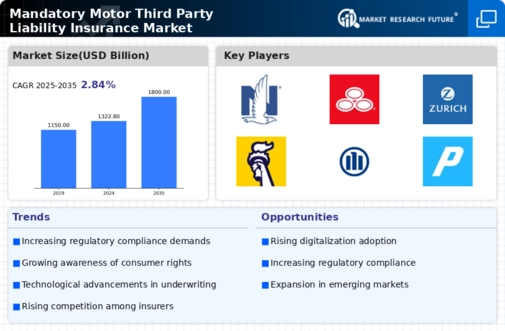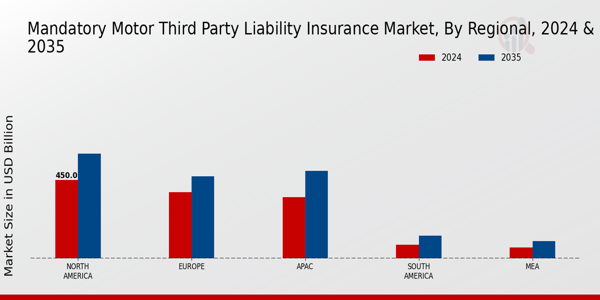Regulatory Frameworks
Stringent regulatory frameworks across various countries significantly influence the Global Mandatory Motor Third Party Liability Insurance Market Industry. Governments enforce mandatory insurance requirements to protect third parties in the event of accidents, thereby fostering a safer driving environment. For instance, many nations have established minimum coverage limits, compelling vehicle owners to secure liability insurance. This regulatory landscape not only enhances consumer protection but also drives market growth. As the market evolves, it is anticipated that these regulations will become more comprehensive, potentially increasing the market size to 1800 USD Billion by 2035, as compliance becomes a critical aspect of vehicle ownership.
Technological Advancements
Technological advancements in the automotive and insurance sectors are reshaping the Global Mandatory Motor Third Party Liability Insurance Market Industry. Innovations such as telematics and artificial intelligence are enhancing risk assessment and pricing models, allowing insurers to offer more personalized coverage options. For example, telematics devices can monitor driving behavior, enabling insurers to reward safe drivers with lower premiums. This shift towards technology-driven solutions not only improves customer satisfaction but also streamlines claims processing. As these technologies become more integrated into the insurance landscape, they are likely to contribute to a compound annual growth rate of 2.84% from 2025 to 2035, further expanding the market.
Increasing Vehicle Ownership
The rise in global vehicle ownership is a primary driver for the Global Mandatory Motor Third Party Liability Insurance Market Industry. As more individuals acquire vehicles, the demand for insurance coverage escalates. In 2024, the market is projected to reach 1322.8 USD Billion, reflecting the growing necessity for liability insurance to protect against potential damages caused by vehicle accidents. This trend is particularly evident in emerging economies, where urbanization and rising disposable incomes contribute to higher vehicle sales. Consequently, the insurance sector must adapt to this increasing demand, ensuring that adequate coverage is available to meet the needs of a burgeoning driver population.
Economic Growth and Urbanization
Economic growth and urbanization are pivotal factors propelling the Global Mandatory Motor Third Party Liability Insurance Market Industry. As economies expand, disposable incomes rise, leading to increased vehicle purchases and, consequently, a higher demand for liability insurance. Urbanization, characterized by population migration to cities, further amplifies this trend, as urban dwellers are more likely to own vehicles. This dynamic is particularly evident in developing nations, where rapid urbanization is occurring. The combination of economic growth and urbanization is expected to sustain the market's upward trajectory, with projections indicating a market size of 1800 USD Billion by 2035, underscoring the interconnection between economic development and insurance needs.
Market Trends and Growth Projections
The Global Mandatory Motor Third Party Liability Insurance Market Industry is poised for substantial growth, with projections indicating a market size of 1322.8 USD Billion in 2024 and an anticipated increase to 1800 USD Billion by 2035. This growth is underpinned by a compound annual growth rate of 2.84% from 2025 to 2035. Various factors contribute to this upward trend, including increasing vehicle ownership, regulatory mandates, and heightened awareness of insurance benefits. As the market evolves, it is essential to monitor these trends and adapt strategies accordingly to capitalize on emerging opportunities.
Rising Awareness of Insurance Benefits
The increasing awareness of the benefits of mandatory motor third party liability insurance is a crucial driver for the Global Mandatory Motor Third Party Liability Insurance Market Industry. As consumers become more informed about the financial protection that liability insurance offers, there is a growing inclination to secure coverage. Educational campaigns by governments and insurance companies play a vital role in this awareness. This trend is particularly pronounced in regions where insurance penetration remains low. As awareness continues to rise, it is expected that more individuals will seek liability insurance, contributing to the market's growth trajectory and reinforcing the importance of safeguarding against potential liabilities.















